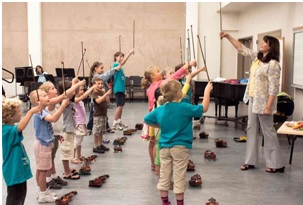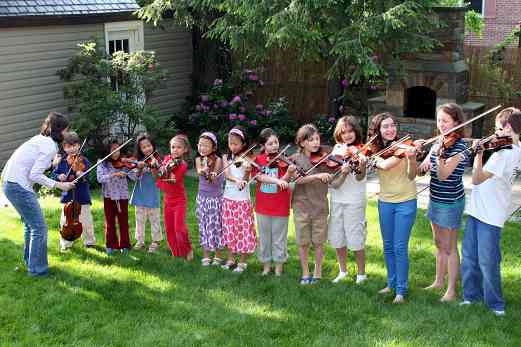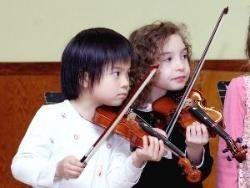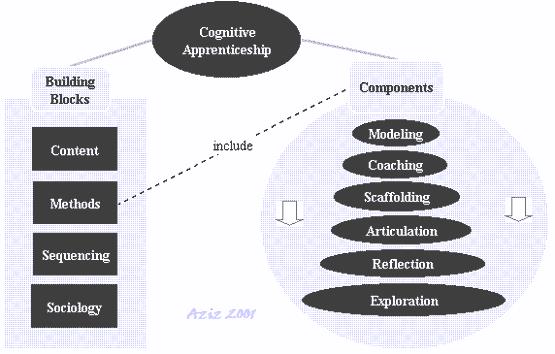Cognitive Apprenticeship
Scenario A
Peter is a Mathematics teacher and is very serious in the acquisition by his students. He adopts a five step approach in daily practice, which are listed below:
Modeling: He works through a Mathematics problem aloud in front of the class and ensure all have well observed and understood about that.
Coaching: Students are then assigned simple questions while Peter walks along and coaches (if deemed necessary).
Articulation: Peter asks the students to say what he/she thinks might be the next step with reasons.
Reflection: After completion of the exercise, Peter works through the questions and shows the steps and solution to his class.
Exploration: At the end of the lesson, Peter further assigns similar problems that make use of daily life data/experience for students to work on.
What kind of teaching model do you think Peter is using? Are you employing similar strategies in your daily practices?
Scenario B
Susan is an experienced violin teacher and she is strict regarding students musical performance of playing violin. She is teaching a class of 20 students with different learning abilities. Some of her students did not perform a song smoothly by violin and always have difficulty in following the beat/tempo. So the teacher adopts different strategies to help her students to acquire expertise through modeling, coaching, scaffolding, reflection and exploration. Which pictures embed these teaching strategies that she employed?

Figure 1. The teacher performs the song by violin for students observation and imitation -> Modeling. Source: https://suzukiassociation.org/media/clifford-cook-teaching-violin-group-class/

Figure 2. The teacher observes and give feedback while students play the violin -> Coaching. Source: https://suzukiassociation.org/media/clifford-cook-teaching-violin-group-class/

Figure 3. Students compare their performance with peers ->Reflection. Source: http://www.colourstringsvan.com/1936.html
Definition
Students do not usually have access to the cognitive and metacognitive processes of instructors, as a basis for learning through observation. Cognitive apprenticeship is a model of instruction that works to make those processes visible where students can observe, enact, and practice them with help from the teacher and from other students.
Cognitive Apprenticeship
- supports learning in a domain by enabling students to acquire, develop and use cognitive tools in authentic domain activity
- enculturate students into authentic practices through activity and social interaction

Figure 1. Cognitive Apprenticeship. Source: https://wss.apan.org/jko/mls/Learning%20Content/Aziz%20-%20Cognitive%20Apprenticeship.pdf
Basic Assumptions and Principles
- Cognitive apprenticeship encourages reflection on differences between novices and expert performance.
- Cognitive apprenticeship encourages the development of self-monitoring and correction skills required for the problem solver to alternate among different cognitive activities.
- Learning, both outside and inside school, advances through collaborative social interaction and the social construction of knowledge. It assumes that people learn from one another, through observation, imitation and modeling
Cognitive Apprenticeship composed of four major components that constitute any learning environment:
- Methods
- Sequencing
- Sociology
- Content
Principles for Designing Cognitive Apprenticeship Enviroments
| Content | Types of knowledge required for expertise | |
|---|---|---|
|
|
Domain knowledge | subject matter specific concepts, facts, and procedures |
|
|
Heuristic strategies | generally applicable techniques for acccomplishing tasks |
|
|
Control strategies | general approaches for directing one’s solution process |
|
|
Learning strategies | knowledge about how to learn new concepts, facts, and procedures |
| Method |
Ways to promote the development of expertise |
|
|
|
Modeling | teacher performs a task so students can observe |
|
|
Coaching | teacher observes and facilitates while students perform a task |
|
|
Scaffolding | teacher provides supports to help the student perform a task |
|
|
Articulation |
teacher encourages students to verbalize their knowledge and thinking |
|
|
Reflection | teacher enables students to compare their performance with others |
|
|
Exploration | teacher invites students to pose and solve their own problems |
| Sequencing | Keys to ordering learning activities | |
|
|
Increasing complexity | meaningful tasks gradually increasing in difficulty |
|
|
Increasing diversity | practice in a variety of situations to emphasize broad application |
|
|
Global to local skills | focus on conceptualizing the whole task before executing the parts |
| Sociology | Social characteristics of learning environments | |
|
|
Situated learning | students learn in the context of working on realistic tasks |
|
|
Community of practice | communication about different ways to accomplish meaningful tasks |
|
|
Intrinsic motivation | students set personal goals to seek skills and solutions |
|
|
Cooperation | students work together to accomplish their goals |
Primary Theorist
Allan Collins

Figure 3. Allan Collins. Source: http://www.sesp.northwestern.edu/images/upload/CollinsAllan.09.jpg
As a cognitive scientist and foundational member of the field of the learning sciences, Collins has influenced several strands of educational research and development.
- Conducted numerous projects investigating the use of technology in schools and developing educational technologies for assessing and improving student learning.
- Developed and studied cognitive apprenticeship as an effective alternative educational practice.
- Advocated for and outlined design-based research methodologies in education
- Produced the first documented example of an intelligent tutor system called SCHOLAR CAI (computer-assisted instruction)
Classroom Implication and Teaching Strategies
Collins, Brown, and Newman (1989)developed six teaching methods:
Modeling
Experts (usually teachers or mentors) demonstrate a task explicitly so the new students or novices can observe. The models should put their thoughts and reasons into words while explaining and demonstrating certain actions, because students cannot otherwise monitor the thinking process (Shunk, 2000).
Specifically, the modeling of cognitive processes requires
- Modeling experts’ performance as they solve problems in realistic contexts
- Externalizing internal/cognitive processes (verbalizing thought processes)
- Encouraging students to think like experts and treating them as experts
- Modeling the performance in different contexts
- Demonstrating how to cope with difficulties (if needed)
Coaching
During Coaching, the expert observes and gives feedback and hints to the novice when he or she performs a task. Coaching can be regarded as the process of overseeing the student’s learning, which begins with helping learners choose their tasks (not always an option), and may end with providing feedback to learners on their completed products.
Many coaching strategies may be employed, including
- providing hints and scaffolding,
- evaluating how learners actually go about the process of learning, diagnosing problems,
- offering verbal and nonverbal encouragement,
- structuring lessons in ways that facilitate learning,
- working with learners to overcome weaknesses
Scaffolding
Scaffolding can be considered only one form of coaching, to help the student perform a task. Collins, Brown, and Newman (1989) describe scaffolding as a kind of cooperative problem-solving effort by teachers and students in which the express intention is for the students to assume as much of the task on his own as possible, as soon as possible.
Scaffolding is based on Vygotsky’s (1978) concept of the zone of proximal development (hyperlink to ZPD). Zhao and Orey (1999) identify six elements of ideal scaffolding:
- sharing of a specific goal, which typically refers to achieving a task
- focusing a whole-task approach, rather than concentrating on individual sub-skills of the task
- providing the immediate availability of help when he is at a point where he needs help in order to continue the task
- assisting learners on whatever they are currently struggling with, not after moving to another task or problem
- providing an optimal level of help only in those steps that that is tailored to the needs of the learner and are beyond the learner’s ability – fading is the notion of slowly removing the support, giving the apprentice more and more responsibility
- conveying of an expert model that will lead the learner to accomplish the task efficiently
Reflection
Reflection involves enabling students to
- compare their own problem-solving processes with those of an expert or of other students, and ultimately, an internal cognitive model of expertise
- look back and examine their performances with a desire for understanding and improvement towards the behavior of an expert
Reflection is enhanced by use of various techniques. One of the most effective ways to improve performance is for learners to evaluate how they did with respect to a set of criteria that determine good performance. Additionally, teacher can pose experientially-based questions, or ask students to construct their own questions, throughout the learning experience –questions that consider content (e.g. who or what?) while emphasizing process (e.g. how and why?)
Exploration
Exploration involves giving students room to problem solve on their own. In other words, exploration is the ultimate fading of support, which allows the student to frame interesting problems within the domain for themselves and then take the initiative to solve these problems.
In addition, computer-based learning environments could provide students with apprenticeship-like experiences, for there is likely to be continued development of new ways to embody these principles in the design the learning environments. For instance, the wide availability of computers and other recording technologies makes performances and feedback easier to produce and to reflect upon.
Resources
The Cambridge handbook of the learning sciences ?Chapters?
Collins, A. (2006). Cognitive apprenticeship. In R. K. Sawyer (ed.), The Cambridge handbook of the learning sciences (pp. 47-60), Cambridge, MA: Cambridge University Press.
Key Works
- Collins, A., Brown, J. S., & Newman, S. E. (1987). Cognitive apprenticeship: Teaching the craft of reading, writing and mathematics (Technical Report No. 403). BBN Laboratories, Cambridge, MA. Centre for the Study of Reading, University of Illinois. January.
- Collins, A., Brown, J. S., & Holum, A. (1991). Cognitive apprenticeship: Making thinking visible. American Educator, 15 (3), 6-11, 38-46 PDF.
- Brown, J. S., Collins, A., & Duguid, P. (1989). Situated cognition and the culture of learning. Educational researcher, 18(1), 32-42.
- Cognitive Apprenticeship
- Let me ‘do’ and I understand: Cognitive apprenticeship
- Collins, A., Brown, J. S., and Newman, S. E. (1989). Cognitive Apprenticeship: Teaching the Craft of Reading, Writing and Mathematics. In L. B. Resnick (ed.) Knowing, Learning, and Instruction: Essays in Honor of Robert Glaser. Hillsdale, NJ: Erlbaum
- Zhao, R., & Orey, M. (1999). The scaffolding process: Concepts, features, and empirical studies. Unpublished manuscript. University of Georgia.
Successful Examples
References
- Collins, A., Brown, J. S., and Newman, S. E. (1989). Cognitive Apprenticeship: Teaching the Craft of Reading, Writing and Mathematics. In L. B. Resnick (ed.) Knowing, Learning, and Instruction: Essays in Honor of Robert Glaser. Hillsdale, NJ: Erlbaum
- Zhao, R., & Orey, M. (1999). The scaffolding process: Concepts, features, and empirical studies. Unpublished manuscript. University of Georgia.